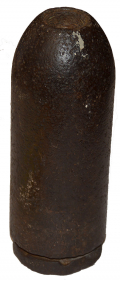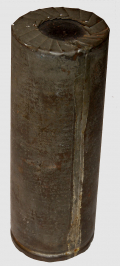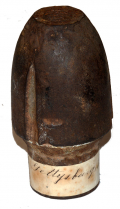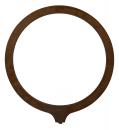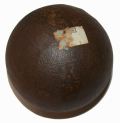site search
online catalog
Artillery
Showing 21 to 40 out of 63
RARE EXPERIMENTAL 10-POUNDER PARROTT SHELL
While the Parrott elongated shell was the standard ammunition for the 3-inch rifled cannons during the Civil War. This specimen is believed to be a very rare early or experimental variation. This… (490-7004). Learn More »
ORIGINAL CIVIL WAR NON-EXCAVATED 3-INCH HOTCHKISS CANISTER ROUND
Measuring 2.9” in diameter and 8” tall, and weighing 6 pounds 15 ounces, this is an original, non-excavated, complete, intact and nicely marked Civil War canister round for the 3-Inch Ordnance… (2025-37). Learn More »
BRITISH ARTILLERY SHIPPING CRATE
This is one of several scarce British artillery crates that recently came to hand, some of which were marked “Quebec.” This is clearly stenciled in black on one end: “11/59” / “W[broad… (2024-1156). Learn More »
BRITISH ARTILLERY SHIPPING CRATE
This is one of several scarce British artillery crates that recently came to hand, some of which were marked “Quebec.” Along with other ordnance and shipping markings, this is clearly stenciled at… (2024-1154). Learn More »
U.S. 3” SCHENKL PERCUSSION SHELL – EAST CAVALRY FIELD, GETTYSBURG - GEISELMAN COLLECTION
This Federal, intact 3” Schenkl percussion shell specimen is a wonderful artillery relic recovered from East Cavalry Field sometime after the Battle of Gettysburg. The percussion shell measures 9”… (2024-2389). Learn More »
U.S. 3” SCHENKL PERCUSSION SHELL FRAGMENT RECOVERED AT HUNTERSTOWN NEAR GETTYSBURG - GEISELMAN COLLECTION
Here is a large, very fine example of shell fragment from a fired, 3” Schenkl percussion projectile that was recovered from the battle of Hunterstown near Gettysburg. Once part of the Detrick… (1179-1293). Learn More »
ARTILLERY GIMLET FOR 12-INCH GUN – WATERVLIET ARSENAL
The "gimlet" has a screw on the end and was intended to be used to remove broken pieces of friction primers from the vent. It could also serve as a priming wire to poke a hole in the powder bag. This… (2024-2312). Learn More »
STONE MOLD HALF FOR LARGE GRAPE SHOT
This piece is an early mold half for a round grape shot ball. This piece measures approximately 3.5” x 2” x 2.5”. The cavity measures just shy of 2” in diameter. The funnel leading into the… (236-1026). Learn More »
T-HANDLE ARTILLERY GIMLET
The "gimlet" has a screw on the end and was intended to be used to remove broken pieces of friction primers from the vent. It could also serve as a priming wire to poke a hole in the powder bag. This… (2024-2313). Learn More »
PACK OF FRANKFORD ARSENAL 5-SECOND FUSES
This pack of 5-second artillery fuses originates from the Frankford Arsenal and was produced in 1864. The pack is constructed of a drilled wood block covered with a printed paper label. This paper… (2024-2339). Learn More »
ARTILLERY VENT PUNCH FOR 12-INCH MORTAR – WATERVLIET ARSENAL
This is a tool for clearing the vent of any obstructions. It has an octagonal head with a hole in the center, and a 21” wire brazed to it. The wire tappers at the end. The flat head is stamped,… (2024-2314). Learn More »
RELIC -- US NAVAL WATERCAP FUSE WITH BUSHING, DATED 1864
Excavated naval watercap fuse dated 1864 and in good condition. This fuse is made of brass with flange on top, with threaded portion and tapered body. A brass bushing is on this fuse to fit into… (2024-2327). Learn More »
3” HOTCHKISS SHELL WITH GETTYSBURG TAG – FROM YORK SPRINGS GAR POST
This shell is part of the collection that was housed at the York Springs GAR Post 551. Many of the items were collected and curated by David Starry, a Civil War veteran who served in an emergency… (1202-230). Learn More »
U.S. ARTILLERY FUSE POUCH MARKED “US”
Very nice condition leather fuse pouch. The leather of the outer flap is in very good condition. There is some crazing on the top “hinge” area of the flap. There is a deep “US” stamp on the… (864-14). Learn More »
1855 DATED 11-INCH SHOT/SHELL GAUGE
These simple iron ring gauges allowed for quick inspection and sorting of shot and shell by size, something of critical importance to a gun crew and a large task given the huge stacks of cannon balls… (490-6754). Learn More »
EXCAVATED U.S. 3” PARROTT SHELL FROM GETTYSBURG GAR POST #9
Here is a Gettysburg excavated Civil War Federal 3” field artillery projectile often referred to as a Parrott Type III shell excavated from an unknown location area on the Gettysburg battlefield… (2024-2135). Learn More »
BRITISH ARTILLERY CRATE FOR 9-POUND SOLID SHOT
The smooth-bore, muzzle-loading 9-pounder cannon was a standard British field-piece in service from 1805 to 1881, with a maximum range of about 1,400 yards and notable service in the Napoleonic Wars… (2024-1155). Learn More »
U.S. / C.S. 12-POUNDER SOLID SHOT – FROM G.A.R. “SKELLY” POST #9, GETTYSBURG
This is the most common solid shot projectile of any caliber used during the Civil War by both the Federal and Confederate forces. This is a solid iron cannon ball with dark brown tone and smooth… (490-6995). Learn More »
CONFEDERATE 3” MULLANE COMMON SHELL
Here is a fired Confederate 3” bourreleted Mullane Type 1 common shell recovered from an unknown battlefield location. Made for the 3” Ordnance Rifle. Also known as a “Tennessee Sabot”, this… (490-7005). Learn More »
U.S. / C.S. 12-POUNDER SOLID SHOT – FROM G.A.R. “SKELLY” POST #9, GETTYSBURG
This is the most common solid shot projectile of any caliber used during the Civil War by both the Federal and Confederate forces. This is a solid iron cannon ball with dark brown tone and smooth… (490-6993). Learn More »
Showing 21 to 40 out of 63
Most Popular
Historical Firearms Stolen From The National Civil War Museum In Harrisburg, Pa »
Theft From Gravesite Of Gen. John Reynolds »
Selection Of Unframed Prints By Don Troiani »
Fine Condition Brass Infantry Bugle Insignia »
British Imported, Confederate Used Bayonet »
Scarce New Model 1865 Sharps Still In Percussion Near Factory New »
featured item
13-STAR CONFEDERATE FIRST NATIONAL FLAG WITH GETTYSBURG HISTORY - “GRIMES COUNTY GREYS,” CO. G, 4th TEXAS INFANTRY, HOOD’S TEXAS BRIGADE
The flag is in very good condition, with strong colors and just a few scattered small holes that do not detract. It has been archivally conserved, mounted and framed by Textile Preservation Associates and comes with their November 2020 treatment… (1179-1393). Learn More »
site search
Upcoming Events
May 16 - 18: N-SSA Spring Nationals, Fort Shenandoah, Winchester, VA Learn More »



